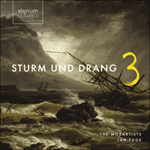
Welcome to Hyperion Records, a British classical label devoted to presenting high-quality recordings of music of all styles and from all periods from the twelfth century to the twenty-first.
Hyperion offers both CDs, and downloads in a number of formats. The site is also available in several languages.
Please use the dropdown buttons to set your preferred options, or use the checkbox to accept the defaults.

| The Mozartists, Ian Page (conductor)» More |
The tense opening movement sums up Haydn’s Sturm und Drang style with its fierce contrasts of dynamics, urgent semiquavers and, towards the end, a brief passage combining contrapuntal imitation with tonality-destabilising chromaticism. Counterpoint is again to the fore in the Minuet, a strict canon between upper and lower strings. The brighter mood of the major-key trio prepares the way for the Adagio, a movement which provides the calm contemplation lacking in the first movement. The finale is one of Haydn’s most remarkable, a movement brimming with nervous energy that is the embodiment of ‘storm and stress’.
from notes by Matthew Rye © 1992
Le mouvement tendu de l’ouverture résume le style Sturm und Drang de Haydn, avec ses nuances aux contrastes violents, ses doubles-croches pressantes et, vers la fin, un passage bref combinant l’imitation contrapuntique à un chromatisme qui déstabilise la tonalité. Dans le Menuet, le contrepoint est de nouveau à l’avant-scène, un canon strict entre les cordes supérieures et inférieures. L’humeur plus vive du trio dans la tonalité majeure prépare la voie à l’Adagio, un mouvement qui fournit la calme contemplation qui manque dans le premier mouvement. La finale est l’une des plus remarquables de Haydn, un mouvement débordant d’énergie nerveuse, l’incarnation même de Sturm und Drang.
extrait des notes rédigées par Matthew Rye © 1992
Français: Martine Erussard
Der spannungsreiche erste Satz mit seinen starken dynamischen Kontrasten, dringenden Sechzehnteln und, zum Ende hin, einer kurzen Passage mit kontrapunktischer Imitation und die Tonalität destabilisierenden Chromatik, ist sozusagen eine Zusammenfassung von Haydns Sturm und Drang. Der Kontrapunkt ist auch im Menuett wieder im Vordergrund, einem strengen Kanon zwischen den höheren und tieferen Streichern. Die leichtere Stimmung des Dur-Trios bereitet den Weg für das Adagio, in dem das ruhige Nachsinnen, das im ersten Satz fehlte, zum Vorschein kommt. Das Finale ist eines der bemerkenswertesten, die Haydn je geschrieben hat—ein mit nervöser Energie überschäumender Satz und wirkliche Verkörperung von „Sturm und Drang“.
aus dem Begleittext von Matthew Rye © 1992
Deutsch: Meckie Hellary
 Sturm und Drang, Vol. 3 Sturm und Drang, Vol. 3Three viscerally dramatic orchestral works frame two operatic rarities in The Mozartists’ latest foray into the artistic maelstrom of the 1770s and ’80s.» More |

